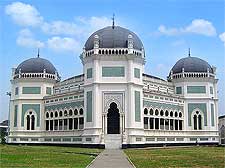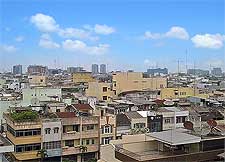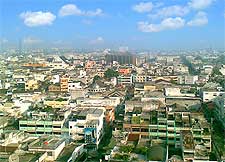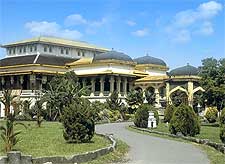Sumatra History Facts and Timeline
(Sumatra, Indonesia)

None of Indonesia's numerous islands were hit harder by the 2004 tsunami than Sumatra, the biggest island situated entirely within the country's boundaries and home to slightly more than 20 percent of the nation's overall population.
Despite two more recent earthquakes in history, combined with the destruction of nearly half of its rainforest area, Sumatra's breathtaking tropical beauty remains its greatest tourist attraction. Indonesia's highest volcano, Mount Kerinci, towers over the Kerinci Seblat National Park, while the Gunung Leuser National Park is the most likely place to spot one of the endangered native orangutans.
Kingdom of Sriwijaya
The 13,000 year old remains of gatherers and hunters on the north coast are the earliest evidence of human settlement on the island, but Sumatra's first permanent settlers did not arrive until roughly 500 BC. The first of the many kingdoms, Kantoli, was established on the island's southern part around 500 AD.
The Srivijaya Buddhist monarchy eventually seized control of both Sumatra and its thriving trade route, between
China and
India along the Straits of Melaka, during the seventh century AD. One of the most famous visitors at this time was the Chinese Buddhist monk named I Ching, who spent four years working and studying Sanskrit in Palembang.

History of the Aceh Sultanate
Islam became Sumatra's dominant religion long after southern India's Chola Empire defeated the Kingdom of Srivijaya in the 11th century. The island welcomed another famous visitor, Marco Polo, in 1292.
The powerful Aceh Sultanate, which defeated the Samudra kingdom in the 14th century, ruled over Sumatra until well into the early 20th century.
Dutch Conquest
Although the Dutch long attempted to conquer Sumatra, as they had done with most of present day Indonesia, they met strong resistance from locals, who would often burn their villages to the ground and settle elsewhere, rather than allow the Dutch to conquer them. It took a lengthy and costly war lasting between 1873 and 1903 for Sumatra to finally become Dutch territory.
The island became a major oil and rubber producer as a Dutch colony, as well as growing much pepper.

Japanese WWII Occupation
The Japanese occupied Sumatra, along with most other Dutch East Indies territory, during WWII. Pulah Weh's Japanese bunkers and the caves (Lobang Jepang) that the Japanese army constructed near Bukittinggi are a couple of the surviving landmarks from this time.
Indonesia's first prime minister and vice president were both from Sumatra and were actively involved in the country's independence movement.

Boxing Day Tsunami
History will always remember the tragedy in 2004, when the Boxing Day tsunami tragically took the lives of some 170,000 Indonesians, most of which lived within Sumatra's northernmost province, Aceh. Two more earthquakes struck in 2005 and 2010.
Tourists are, however, starting to return to this ruggedly beautiful island and a large chunk of Sumatra's surviving rainforest is now a UNESCO World Heritage Site.
 None of Indonesia's numerous islands were hit harder by the 2004 tsunami than Sumatra, the biggest island situated entirely within the country's boundaries and home to slightly more than 20 percent of the nation's overall population.
None of Indonesia's numerous islands were hit harder by the 2004 tsunami than Sumatra, the biggest island situated entirely within the country's boundaries and home to slightly more than 20 percent of the nation's overall population.

